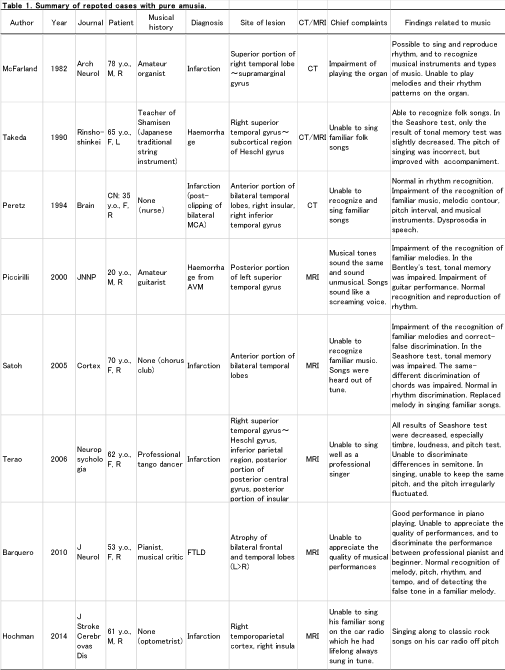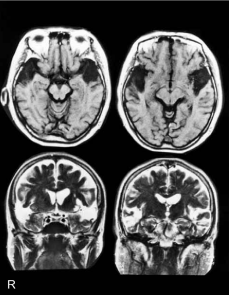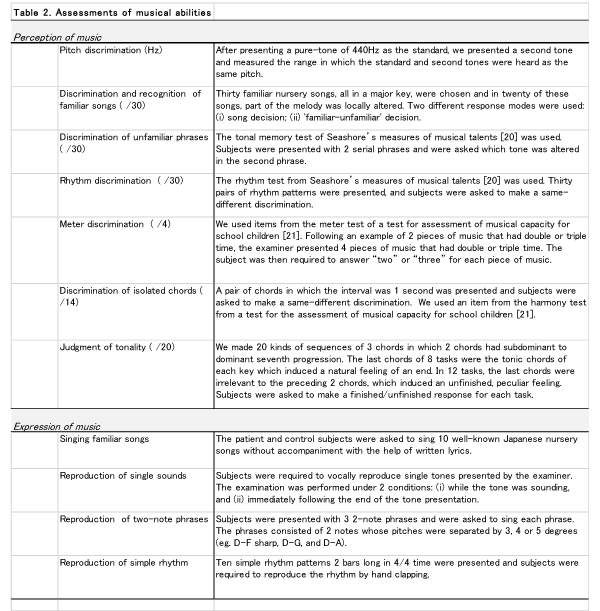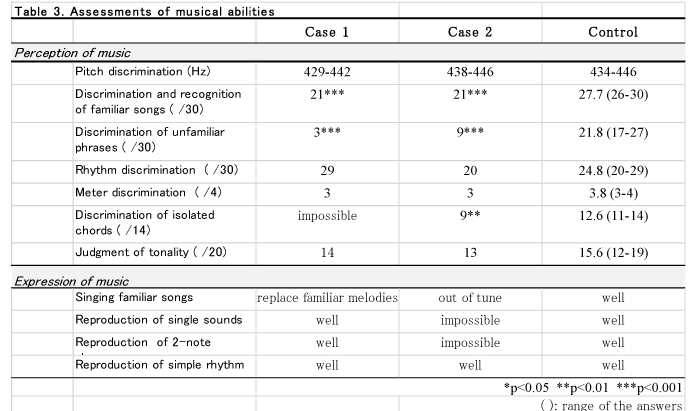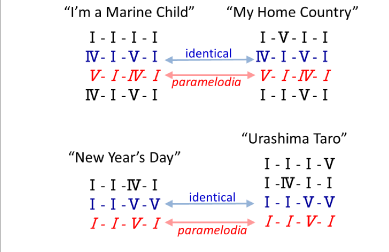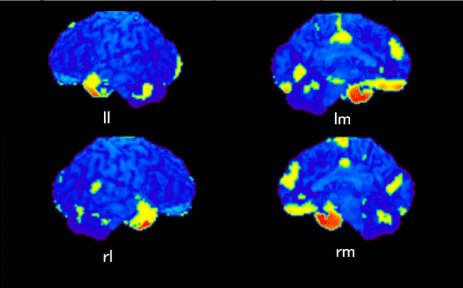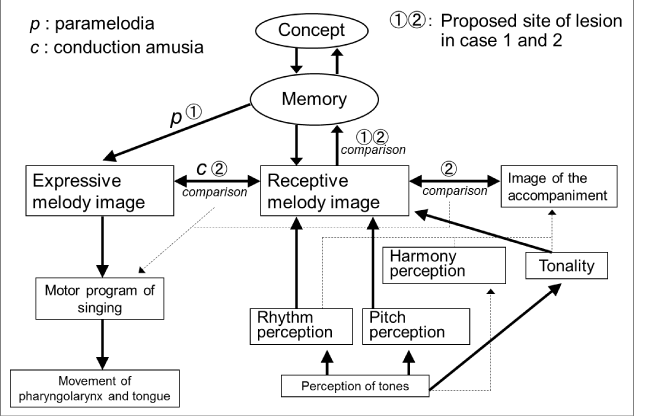
Review Article
Austin J Clin Neurol 2014;1(2): 1009.
Musical Processing in the Brain: A Neuropsychological Approach through Cases with Amusia
Masayuki Satoh*
Dementia Prevention and Therapeutics, Mie University, Japan
*Corresponding author: Masayuki Satoh, Dementia Prevention and Therapeutics, Graduate School of Medicine, Mie University, 2-174 Edobashi, Tsu, Mie 514- 8507, Japan
Received: March 18, 2014; Accepted: April 02, 2014; Published: April 17, 2014
Abstract
Over the last decade, a considerable number of studies have been made on the cognitive processing of music. In this review, I discuss the cognitive processing of music based on the findings of our amusic cases. A patient with pure amusia (case 1) due to infarction of the anterior portion of the bilateral temporal lobes revealed a disturbance in the discrimination of chords. The patient also showed an impairment in singing familiar songs, along with the replacement of phrases (paramelodia). My positron emission topography (PET) study, which investigated the brain regions participating in chord perception, showed bilateral activation of the anterior portion of the temporal lobes. From the results of this clinical case and PET study, I can reasonably conclude that these brain regions have a relationship with chord perception. The second patient (case 2) had a large infarction of the bilateral temporal lobes, and also exhibited word deafness, environmental sound agnosia and receptive and expressive amusia. Thoughthe patient produced normal scores in tasks of chord and pitch discrimination, the recognition of tonality was impaired. It was suggested that tonality might be one of the independent factors for receptive processing of music. From these findings, some characteristic symptoms of amusia are described and I present a diagram regarding musical processing in the brain.
Keywords: Amusia; Neuropsychology; Paramelodia; Conduction amusia; Chord
Introduction
It is often said that music has no borders. It is also a fact that there are differences in the style and content of music, depending on the culture and the era. However, among members of the same culture, music can evoke the same feeling immediately and easily. For example, adults who live in cultural areas related to western music need less than 0.25 seconds to identify whether the music is happy or sad [1]. This nature of music is assumed to be useful to the adaptation of living in human society. Music can act as a strategy for non-verbal communication, to associate citizens and to facilitate the unity of a group. In this process, two components of music (pitch and rhythm) are thought to play an important role. When some tones sound with a specific frequency ratio, these tones make a consonance. Moreover, the regularity of time makes the movements of most people synchronize, as in dancing [2]. Therefore, one way to know how music is recognized and represented in the brain may be to understand the relationship between human behavior and the brain. In this review, I describe two cases of amusia who showed the impairment of musical ability due to the brain damage, and propose some aspects about the perception and coding of music in the brain.
Amusia
Definition of amusia
It is widely accepted that neuropsychology began from the first case report of aphasia by Broca. A few years later, it was reported that not only language but also music was impaired by brain damage [3].A musician with aphasia could not read a musical score [3] or hum a tune [3]. The concept of amusia appeared on the stage.
Amusia is defined as an acquired deficit of music processing [4]. In musicology, it is thought that melody, rhythm, and harmony are the three basic components of music. Melody is the tonal sequence made up of changes in pitch and rhythm, which are integrated into an entity. In other words, I can say that these three components are pitch, rhythm and harmony. As mentioned below, tonality is sometimes regarded as another component of music [5,6]. Because several cases with pure amusia, meaning the sole impairment of musical ability without affecting the other cognitive functions, have been reported, it was supposed that music has an independent processing in the brain, at least to some extent [7].
Diagnosis and categorization of amusia
Musical ability consists of the perception of the basic components (such as pitch and rhythm), the singing and playing of musical instruments, the reading and writing of musical scores and musical appreciation with emotional experiences [8,9]. When one or more of these abilities are impaired by brain damage, dysfunctionality, and influences of drugs, the patient is diagnosed with amusia.
The categorization of amusia corresponds to that of aphasia (Figure 1). Amusia is generally classified as one of two types, receptive or expressive [10,11]. Receptive amusia specifies an inability to remember (amnestic amusia), read (musical alexia) or understand music (narrow receptive amusia), while expressive amusia indicatesdifficulty in singing (oral–expressive amusia), writing music (musical agraphia), or in instrumental performance (instrumental amusia or musical apraxia) [12]. In reported cases of receptive amusia, the degree of the impairment of pitch and rhythm are different in their severity, suggesting that perception of these two music components occurs independently in the brain [13]. Studies of expressive amusia have shown that the degree of the impairment differs between singing and instrument playing [14], thus expressive amusia is often subdivided into vocal and instrumental motor amusia.
Figure 1: Categorization of amusia based on case studies. This categorization corresponds to that of aphasia.
Peretz [15] suggested that tonality was an independent component of musical perception. She examined in detail a patient with amusia due to a bilateral infarction of the temporal lobes. The patient was unable to perceive sequential pitch structure, particularly when pitch intervals required tonal interpretation, in the presence of accurate encoding of melodic contour and of interval sizes. Peretz concluded that the impairment of her patient derived from auditory atonalia as a consequence of brain damage. Further, I experienced a patient with an infraction of bilateral temporal lobes who showed an impairment of melody perception, though the ability of tonality perception was preserved [6]. By comparing the results of our patient with those of Peretz’ patient [15], I can identify a double dissociation between the impairment of tonality and of other musical components. The patient reported by Peretz had an impairment of tonality with the absence of perception of melody, whereas my patient retained the feeling of tonality with an impairment of perception of melody and chord. This double dissociation revealed that tonality might be an independent component of the perception of music [6].
Reported literature cases of amusia
There are fewer than one hundred amusic cases in the literature. Among them, about fifty cases had detailed descriptions of symptoms, findings and sites of lesions. There are more cases with left than right hemisphere lesions, because in many cases functional differences between language and music in aphasia were investigated, though musical ability could be completely preserveddespite aphasia. Therefore, the left dominance of the reported casesdoes not necessarily demonstrate that amusia is more likely to occur via left hemisphere lesions. Most of the reported amusic cases were professional musicians or talented amateur musicians who possessed high levels of musical ability. Almost all of the amusic cases in the literature had multiple impairments of cognitive function other than music, and it could not be determined to what extent these impairments affected the occurrence of amusia. Further, thediscrimination of the lesions responsible for amusia from those related to other cognitive dysfunctions was impossible. Therefore, I may reasonably conclude that cases of pure amusia can best reveal the relationship between amusic symptoms and responsible lesionsmore clearly and directly. There are only eight reported cases with pure amusia (Table 1). The typical case of pure amusia was twenty years old amateur guitarist who showed receptive and expressive amusia after cerebral hemorrhage from arteriovenous malformation (AVM). Due to the damage of posterior portion of left superior temporal gyrus, he complained that musical tones sound the same and unmusical, and songs sound like a screaming voice. In addition to the close examination of musical ability, the authors explored other cognitive functions in detail of the memory, attention, visuospatial function, praxis, psychomotor integration, and intellectual processes, all of which were within normal limits. Based on the cases of pure amusia shown in the Table 1 and reported amusic cases with other cognitive impairments, there is a fairly general agreement regarding the cognitive processing of music in the brain as follows: i) cognitive processing of music and language share a common neural pathway, at least partially, ii) in amusic cases, impairments in pitch are more common than impairments in rhythm, iii) the impairment of musical expression (expressive amusia) such as singing and instrumental playing tend to be caused by damage of the right hemisphere, and iv) receptive amusia is caused by the damage of right or bilateral temporal lobe(s).
Figure 7: Table 1. Summary of repoted cases with pure amusia.
Figure 8: Table 1. Summary of repoted cases with pure amusia (continued).
Cases of amusia
Regarding musical processing in the brain, I had the opportunitiesto examine cases with amusia [6,11], musical hallucination [16], callosal disconnection in a violinist [17], singing seizure [18], and musical anhedonia [9]. In this paragraph, I introduce two amusic cases and summarize principal findings related to their symptoms.
Case reports
Case 1: Pure amusia[11]
A 70–year–old right–handed woman had an episode of bilateral infarction of the temporal lobes 17 years prior to our study. Acutely, she suffered from right hemiparesis and aphasia, which disappeared after several months. Following her discharge, she found herself unable to recognize familiar music. The symptoms remained unchanged for 17 years, and her musical ability had never been tested.
On June 19, 1999, the patient developed a sudden mild right hemiparesis and was admitted to a hospital in Tokyo. No dementia, sensory disturbances, aphasia, apraxia, dyscalculia, or visual discrimination difficulties were detected. The pure–tone and speech audiometries were also within normal limits. No apparent deficit was detected in the patient’s receptive and expressive speech, as assessed by two aphasic battery sub–tests; notably she obtained a normal score (164⁄167) on the Token test. The right hemiparesis disappeared in one week. Brain MRI confirmed the existence of bilateral temporal lobe lesions (Figure 2), and also revealed a small new infarction at the left coronal radiation. The patient was referred to me for assessment of her impairment in musical ability. Her musical background was that of a non–musician who enjoyed listening to popular and classical music, and regularly attended concerts before her illness. She met criteria for Grison’s third level of musical culture [19]. She had completed 14 years of formal education and had suffered from arrhythmia and hypertension for twenty years.
Figure 2: Brain MRI of Case 1. Brain MRI of the patient carried out 17 years after the onset of amusia. Upper and lower images show axial T1 and coronal T2 weighted images, respectively. Old infarcted lesions are observed bilaterally in the anterior portion of the temporal lobes including the temporal poles.
Her complaints about music were as follows: i) despite her former experience as a tango dancer, she could no longer distinguish tango from other types of music and she could identify tango music only by looking at a dancer’s steps, ii) when she heard her recorded disc to which she had repeatedly listened, she felt as if she listened to the songs for the first time, and iii) she perceived her singing as out of tune when it was not.
Case 2: Auditory agnosia with impairment of perception and expression of music [6]
A 68–year–old right–handed businessman suffered from aphasia following an infraction in the left temporal lobe in 1989. The aphasia whose main symptom was anomia in his business situation disappeared in a few years and no neuropsychological deficitremained. On the morning of January 3, 1996, he found it hard to hear spoken language. He could hear voices on the television and telephone, but he could not understand what was said. He could speak fluently and write and read correctly. He had no weakness, no sensory disturbance, no apraxia, no dyscalculia, nor any visual discrimination difficulties. He consulted a hospital on January 24, and a brain MRI revealed a new infarction in the right temporal lobe (Figure 3). Puret one audiometry revealed a slight deficit in the high frequency area that was within normal limits for his age. Speech audiometry revealed that the degree of maximal discrimination was only 50% in each ear. He had a low score (143⁄167) on the Token test, but, when questioned by written language, his score improved to 159. He also had a mild difficulty in understanding environmental sounds. His ability to hear spoken language improved gradually for a year. He was diagnosed with auditory agnosia (namely pure word deafness, environmental sound agnosia and receptive amusia) and expressive amusia.
Figure 3: Brain MRI of Case 2.Axial MRI images of the patient carried out 2 years after the onset. Upper and lower images show the T1– and T2–weighted images, respectively. Old infarcted lesions are observed in bilateral temporal lobes more extensively on the right.
In June 1999, he was referred to my laboratory because of his persistent complaints concerning the disturbance of perception and expression of music. He had never taken music lessons but enjoyed listening to recorded music and live concerts. He met the criteria for Grison’s third level of musical culture [19] and had suffered from arrhythmia for ten years.
His complaints about music processing were as follows: i) his singing became completely out of tune, ii) the music that he hadenjoyed listening to before was wearisome and the esthetic pleasure was gone, iii) when he sang familiar songs with the accompaniment of karaoke, he could hear the accompaniment during the prelude, but as soon as he started to sing, he could not listen to the accompaniment completely, and iv) he could not understand spoken words when there was background music (BGM).
Results of neuromusicological assessments
In order to investigate the musical abilities of our patients, I carried out assessments of perception and expression of music, and performed statistical analysis of the results between my patients and controls. The contents of the assessments are shown in Table 2. Eight male and 4 female right–handed subjects with no history of neurological or psychiatric disease served as controls. Their ages ranged from 55 to 72 years (mean age 62 years). Control subjects were volunteers with musical background and education similar to those of my patients.
Figure 9: Table 2. Assessments of musical abilities
The results are shown in Table 3. Case 1 reported that she could not discriminate isolated chords because all of the chords sounded the same to her. The patient could correctly sing songs she knew well, such as “The Moon”. However, in singing less familiar songs, her singing was sometimes out of tune, though the rhythm and contour of the melody were preserved. When she sang an old Japanese tune in quadruple time (“I’m a Marine Child”), the third phrase of that melody was replaced with a phrase of a tune in triple time (“My Home Country”). When she sang “New Year’s Day”, the fourth phrase of that melody was replaced with the fourth phrase of another tune (“Urashima Taro”). The patient reported that such replacement of melody often occurred when she sang at home. Twenty minutes after this episode, she was able to sing these songs correctly. In the reproduction of two–note phrases, control subjects could discriminate and reproduce these two–note phrases easily, while patient 1 was unable to tell the difference between the phrases. She stated that all phrases sounded similar. Despite her inability to discriminate the phrases, she could correctly sing each phrase.
Figure 10: Table 3. Assessments of musical abilities
In case 2, the discrimination of isolated chords was compromised, but the judgment of tonality was the same as that of controls. The singing of case 2 was entirely out of tune, even of songs he knew well. The rhythm and the contour of the melody were mostly preserved. The pitch was severely impaired, as if frequent disordered transposition occurred. He was not aware of the inaccuracy of his own singing. Accompaniment by keyboard did not improve his performance. All control subjects could readily reproduce the single tone during and following termination of the tone presentation. Patient 2 could not reproduce a single sound presented by the examiner following the termination of tone presentation, in spite of his efforts over about ten minutes. He could not fix the pitch of tones, and he did not notice this. In the reproduction during the tone presentation, he complained that he could not hear the sounding tone, and he could not judge whether his own singing was correct or not. Control subjects could discriminate and reproduce 3 simple phrases easily. Patient 2 could discriminate 3 simple phrases, but sang them entirely out of tune.
Discussion
Based on the results of cases 1 and 2, and of the literature covering case and my previous activation studies, I present the followingaspects regarding the perception and expression of music.
Paramelodia
In neurocognitive science, it is generally accepted that memory consists of three steps: encoding, storage and retrieval. ‘Encoding’ is the uptake of the information into the brain, ‘storage’ concerns the keeping of information in the brain, and ‘retrieval (or recall)’ is the recollection of stored information when it is necessary. These steps can also be applied to music processing. For example, in singing, the information of the melody is retrieved, then it is changed into movements of the pharyngolarynx, and finally the song is uttered.
In case 1, the phrases of some melodies were replaced with those of other ones, while she sung well–known nursery songs. On another day, she could correctly sing these songs and it was supposed that the storage of these songs was preserved. Therefore, her symptoms of replacing melodies might be caused by a disturbance in the retrieval of melodies. Similar to paraphasia, which is the impairment of repeating words or sentences due to a retrieval dysfunction in aphasia, I named this symptom paramelodia. It is noteworthy that in paramelodia, the replacement of melodies occurred in a unit of four bars and one phrase. This fact suggests that the song is retrieved during singing by a unit of one phrase, and not in its entirety. We may say that singing familiar songs is based on a parallel processing of retrieval of phrases simultaneously while singing. The length of most modern folk and nursery songs in Western style is four, eight, twelve, or sixteen bars, and so on. Thus, “four bars” might be a fundamental unit of melodic organization, at least in Western music from about 1600 on.
How does paramelodia occur? The contours and times of replaced melodies were quite different. I noted the particular similarity of the harmony progression of the preceding phrase of replaced melodies (Figure 4). Consequently, I may say that the paramelodia was caused by a similarity of the harmony of the preceding phrase. In other words, when we retrieve melody from memory storage, we may retrieve following phrases based on information related to the harmony progression of the preceding phrase. Further studies are needed to clarify the cognitive processing of the retrieval of a beginning phrase of a tune.
Figure 4: Paramelodia and Harmony Progression
Conduction amusia
The mechanism of expressive amusia can be hypothesized according to two mechanisms. When a patient complains that he⁄she cannot sing well, it is possible that the patient has an impairment of the expressive system itself or a disconnection between the receptive and expressive systems related to music. An amateur accordion player reported by Botez [22] could not sing the same single tone presented on a keyboard, though he completely understood the incorrectness of his singing. He could correctly sing a scale and also perceive the pitch of a single tone. Therefore, it was supposed that his singing impairment was caused by an in capability to utilize the pitch information of the perceived tone for his singing.
My case 2 could discriminate the pitch difference correctly and utter a voice at an arbitrary pitch. These facts demonstrate that his ability to perceive and utter a single tone was preserved. However, he could not sing the same single tone presented by the examiner. So, I may reasonably conclude that the auto regulation of pitch control did not function because the perceived pitch information was not processed into singing. I named this symptom conduction amusia, meaning disconnection between the receptive and expressive systems of music processing. A case study that has an intact expressive system but cannot sing a single tone the same as the represented pitch would further clarify this type of disconnection.
Chord perception and anterior temporal lobes
Case 1 complained that a pair of chords sounded quite similar to her. From her case, I may say that the anterior portion of the temporal lobes plays some role in chord recognition.
I performed a PET activation study that recorded activated brain regions during chord and melody perception [23]. The subjects were young, right–handed non–musicians (age 20~30 years old). They listened to three newly composed musical pieces (C major, 24 bars, three vocal parts) in the following two ways: i) a harmony listening task, and ii) a soprano listening task. During the task performances, I measured regional cerebral blood flow (rCBF) using PET and identified the brain regions that activated in each task. As a result, during the harmony listening task, the anterior portion of the bilateral temporal lobes, cingulate gyri, and cerebellum were activated, compared to the soprano listening task (Figure5).
The results of our case 1 and a PET activation study can be summarized as follows: the recognition of chords was impaired in a case of pure amusia with lesions of the anterior portion of the bilateral temporal lobes and, in a PET study, the same brain regions were activated during a harmony listening task. Therefore, I may say that the anterior temporal lobes participate in the recognition of chords.
Karaoke and a cappella
Most songs consist of a melody and an accompaniment. The term karaoke refers to singing with automated accompaniment. When we sing correctly in karaoke, it is necessary not only to sing melodies in correct pitches, rhythms, and tempo, but also to listen to accompaniments and regulate our own singing, keeping harmony with the accompaniment. After the cerebro vascular accident, the performance of singing with karaoke became worse in case 2 and the patient complained that the accompaniment could not be heard as soon as he started to sing. This phenomenon was different from the situation in which he could listen to the accompaniment and could not keep in harmony with it. This symptom might be caused by a decrease in cognitive volume of the information that he could deal with simultaneously.
Figure 5: PET Activation Study after Harmony-Listening Task. Activation maps for comparison of the harmony–listening versus the soprano–listening tasks. Areas of significant activation (p<0.01) are superimposed onto the surface maps of the averaged MR imaging. Anterior portions of the bilateral temporal lobes are activated. ll: lateral surface of left hemisphere, lm: medial surface of left hemisphere, rl: lateral surface of right hemisphere, rm: medial surface of right hemisphere.
The problem of figure–ground segregation in human cognition has been extensively studied in the field of vision research. A similar condition in audition is known as the cocktail party effect. Even in a noisy situation such as a cocktail party, we can notice when our own names are called or we can listen to selective speeches in the conversation. It is generally accepted that auditory attention participates in the cocktail party effect, but its mechanism and associated brain regions are still uncertain. The findings from case 2 might provide some clues to this mystery.
Tonality
Most music to which we usually listen is based on tonality. Tonality is a term to denote the series of relationships between pitches in which one particular pitch, the ‘tonic’, is central [24]. It takes in the term ‘key’ but also has wide implications, especially concerning the functional association of other notes and chords with the tonic. So, the tonality cannot exist by a single tone or chord, but is built on the relationship between multiple tones and chords. In other words, the melody and harmony progression are necessary toproduce the tonality. Then, is the tonality a derivative product based on the perception of melody and harmony? Or, is it an independent component in the perception of music? Peretz reported a patient with an impairment in the perception of tonality, and concluded that the tonality could be an independent component in the perception of music [15]. The patient exhibited a preserved ability in melody and harmony perception, but she could not perceive tonality. The findings of my case 2 displayed a preservation of tonality, though the perception of the melody and chords was impaired. The results of case 2 were strange. It was supposed that the judgment of end perception based on the progression of three chords was more difficult from the discrimination between a pair of isolated chords. Regarding the perception of tonality, a double dissociation was observed between the results of Peretz’s and my case 2: the case of Peretz showed a preserved melody and harmony and impaired tonality, and my case revealed the counter pattern. From these results, I can reasonably conclude that tonality is an independent component of music perception.
Diagram of the perception and expression of music (Figure 6)
Based on findings from the reported literature and in my patients, I constructed a diagram concerningthe mechanismsrelated to the perception and expression of music, though much still remains to be clarified.
Figure 6: Perception and Expression of Music
Perception of music– The dissociation between the perception of rhythm and pitch reveals that rhythm and pitch are perceived by different processes. My cases showed a double dissociation with the case of amusia due to rhythm agnosia reported by Mavlov [13]. At the first stage, when we listen to music, the melody is perceived as divided into pitch and rhythm. These two components that had been subdivided are then integrated again and form the receptive melody–image, meaning the representation of internal imagery [25] of the melody. The receptive melody–image includes the short term or working memory (STM) of melody. When asked to discriminate the two phrases, the receptive melody–image of the former phrase is compared with the latter phrase in the receptive melody–image. The comparison between the receptive melody–image and the memory is thought to be impaired in both patients. Harmony is defined as the combining of notes simultaneously, to produce chords [24]. Takeuchi suggested that there was a difference in mechanisms between the perception of a single tone and of the pitch–interval, presumably related tothe pitch and the harmony [26]. The tune is usually composed of the melody and the accompaniment. While listening to music with the accompaniment, information about the rhythm and pitch of the tune form not only the receptive melody–image but also the image of the accompaniment. When asked to judge the suitability between the melody and its accompaniment, the receptive melody–image is compared with the image of the accompaniment. This process might be dysregulated in case 2. The harmony and the tonality are also independent components of music perception and related to the formation of the image of the accompaniment.
Expression of music– When we sing a familiar song, the melody is retrieved from memory by a unit of four bars and forms the expressive melody–image, as shown in our study. Dysfunction of this retrieval produces paramelodia, as incase 1. While singing, self–regulation is performed by making a comparison between theexpressive melody–image and the receptive melody–image. This comparison is hypothesized to be impaired in case 2. The results of this comparison and the comparison between the receptive melodyimage and the image of the accompaniment modulate the motorprogram for singing. When asked to sing a melody or a phrase to which the subject is listening for the first time, the melody or phrase information is connected to the expressive melody–image from the receptive melody–image. The connection from the receptive to the expressive system might be dysfunctional in case 2. The expressive melody–image connects to the motor–program for singing and, finally, produces the movements of the pharyngolarynx and tongue, that is, “singing”.
Conclusions
The perception and expression of music has long been considered by philosophy and musicology. Now, we possess innovative tools for functional activation studies, while the importance of case studies in driving cognitive neuroscience has become much greater than ever. I can say that, with the delay of one and a half century, the research of cognitive processing of music is going to approximate to that of language.
References
- Peretz I, Gagnon L, Bouchard B. Music and emotion: perceptual determinants, immediacy, and isolation after brain damage. Cognition. 1998; 68: 111-141.
- Peretz I. Listen to the brain: Biological perspective on musical emotion. Juslin PN, Sloboda JA, Editors. In: Music and emotion . Oxford University Press. North Yorkshire, USA. 2001; 105-134.
- Proust A. Arch. Gen. Med. Critchley M, Henson RA, editors. In Music and the Brain: Studies in the Neurology of Music. William Heineman, London. 1977; 253.
- Loring DW, Meador KJ. INS Dictionary of Neuropsychology. Oxford University Press, New York. 1999.
- Balzano G J. The pitch set as a level of description for studying musical pitch perception. InMusic, Mind and BrainClynes, M. Ed, Plenum Press, New York. 1982; 321-351.
- Satoh M, Takeda K, Kuzuhara S. A case of auditory agnosia with impairment of perception and expression of music: cognitive processing of tonality. Eur Neurol. 2007; 58: 70-77.
- Alossa N, Castelli L. Amusia and musical functioning. Eur Neurol. 2009; 61: 269-277.
- Juslin PN, Västfjäll D. Emotional responses to music: the need to consider underlying mechanisms. Behav Brain Sci. 2008; 31: 559-575.
- Satoh M, Nakase T, Nagata K, Tomimoto H. Musical anhedonia: selective loss of emotional experience in listening to music. Neurocase. 2011; 17: 410-417.
- Wertheim N, The amusias. In Vinken, P.J. Bruyn, G.W.Ed, Handbook of Clinical Neurology. North-Holland Publishing, Amsterdam, 1969; 4: 195-206.
- Satoh M, Takeda K, Murakami Y, Onouchi K, Inoue K. A case of amusia caused by the infarction of anterior portion of bilateral temporal lobes. Cortex. 2005; 41: 77-83.
- Henson R A, Neurological aspects of musical experience. InMusic and the Brain: Studies in the Neurology of MusicCritchley M, Henson R.A, William Heineman, London, 1977; 3-21.
- Mavlov L. Amusia due to rhythm agnosia in a musician with left hemisphere damage: a non-auditory supramodal defect. Cortex. 1980; 16: 331-338.
- McFarland HR, Fortin D. Amusia due to right temporoparietal infarct. Arch Neurol. 1982; 39: 725-727.
- Peretz. I. Auditory Atonalia for Melodies. CognNeuropsychol. 1993; 10: 21-56.
- Satoh M, Kokubo M, Kuzuhara S. A case of idiopathic musical hallucination with increasing repertoire. J Neurol Neurosurg Psychiatry. 2007; 78: 203-204.
- Satoh M, Furukawa K, Takeda K, Kuzuhara S. Left hemianomia of musical symbols caused by callosal infarction. J Neurol Neurosurg Psychiatry. 2006; 77: 705-706.
- Shindo A, Satoh M, Ii Y, Kuzuhara S. Case of singing seizure using syllable names. Neurologist. 2011; 17: 28-30.
- Grison B, Une etude sur les alterations musicales au cours des lesions hemispheriques These. Paris, 1972. Cited by Benton, A.L. The amusias. InMusic and the Brain: Studies in the Neurology of MusicCritchley M., Henson R.A. William Heineman, London, 1977; 378-397.
- Seashore C E. Lewis D Saetveit J, Seashore measures of musical talents. The Psychological Corporation, New York, 1960.
- Mashino A, Hamano M, Motegi S, The test for the assessment of musical ability for schoolchildren. Nihon-Bunka-Kagakusya, Tokyo, 1979.
- BOTEZ M, WERTHEIM N. Expressive aphasia and amusia following right frontal lesion in a right-handed man. Brain. 1959; 82: 186-202.
- Satoh M1, Takeda K, Nagata K, Hatazawa J, Kuzuhara S . The anterior portion of the bilateral temporal lobes participates in music perception: a positron emission tomography study. AJNR Am J Neuroradiol. 2003; 24: 1843-1848.
- Sadie S, The Grove concise dictionary of music. Macmillan, London, 1994.
- Kolb B, Whishaw, I Q, Attention, Imagery, and Consciousness. In Kolb, B Whishaw, I Q, Fundamentals of human neuropsychology. W.H. Freeman and Company. New York. 1996; 465-489.
- Takeuchi AH, Hulse SH. Absolute pitch. Psychol Bull. 1993; 113: 345-361.

